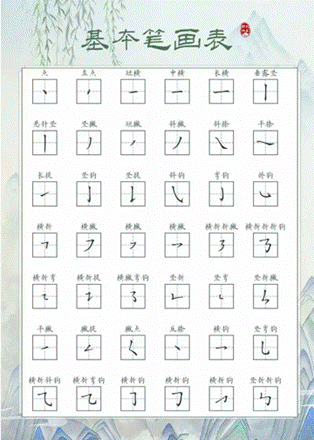
If you’ve ever tried to write Chinese characters, you might have stared at a simple one like “人” (rén, person) and wondered: Why does it have two strokes, not three? Or why does “木” (mù, tree) start with a horizontal line instead of a vertical one? These seemingly small details—strokes—are the building blocks of Chinese writing, carrying thousands of years of history and holding the key to mastering Mandarin.
Where Do Chinese Strokes Come From?
Chinese characters didn’t pop up overnight with fixed strokes. They evolved from pictographs (picture-based symbols) used over 3,000 years ago, during the Shang Dynasty. Back then, people carved symbols on oracle bones to record divinations: a “sun” was drawn as a circle with a dot in the center (⊙), and a “moon” as a curved shape (☽).
As time passed, these pictures simplified into the strokes we know today. For example:
• The ancient pictograph for “water” (水) looked like wavy lines representing flowing rivers. It gradually turned into the 4-stroke character “水” we write now.
• “Fire” (火) started as a symbol with flame-like shapes. It was streamlined into 4 strokes to make writing faster and more consistent.
Strokes weren’t just random, though. They were standardized over dynasties (like during the Qin Dynasty’s “small seal script”) to ensure people across China could read and write the same characters—turning messy pictures into a unified system.
Why Strokes Are Non-Negotiable for Learning Mandarin
You might think, “Can’t I just draw a character however it looks?” But strokes are far more important than you might realize:
1. Strokes define a character’s identity
Mixing up strokes can turn one character into a completely different (and sometimes meaningless) one. For example:
• “人” (rén, person) has two strokes: a撇 (piě, left-falling stroke) and a捺 (nà, right-falling stroke). If you swap their order or add a stroke, it’s no longer “人.”
• “土” (tǔ, earth) has 3 strokes (horizontal, vertical, horizontal). Flip the last two strokes, and you get “士” (shì, scholar)—a character with a totally different meaning.
Wrong strokes don’t just confuse readers; they make your writing unrecognizable.
2. Stroke order builds muscle memory (and saves time)
Every Chinese character has a fixed “stroke order” (笔顺, bǐshùn)—rules like “horizontal before vertical” or “left-falling before right-falling.” Following this order isn’t just tradition; it’s practical.
When you write in the right order, your hand moves naturally, like following a map. Over time, you’ll remember characters faster because your muscles “learn” the pattern. For example, writing “木” (mù, tree) in the correct order (horizontal → vertical → left-falling → right-falling) feels smoother than scribbling it randomly—and you’ll never forget how it’s structured.
3. Strokes connect to pronunciation (yes, really!)
Many Chinese characters are “phono-semantic compounds” (形声字, xíngshēngzì)—they have a “meaning part” (形旁, xíngpáng) and a “sound part” (声旁, shēngpáng). The sound part often has a consistent stroke structure that hints at pronunciation.
Take “青” (qīng, blue/green) as an example. It’s the sound part for “清” (qīng, clear), “情” (qíng, feeling), and “晴” (qíng, sunny). All these characters share parts of “青”’s stroke pattern—and their pronunciations are similar. Learning strokes helps you spot these patterns, making it easier to guess how new characters sound.
How to Master Strokes (and Become Better at Mandarin)
You don’t need to memorize every stroke rule overnight. Start small, and be consistent:
• Learn the basic strokes first: There are only about 8 core strokes (like horizontal 一, vertical 丨, left-falling 丿, right-falling 捺). Master these, and you’ll see them in every character.
• Practice with simple characters: Start with 1-3 stroke characters (e.g., “一” yī, “二” èr, “三” sān) to get used to stroke order.
• Use tools to check: Apps like Pleco or Hanping show stroke order animations—watch them, then copy the motion with a pen.
Remember: Strokes aren’t just “lines on paper.” They’re a bridge to understanding Chinese culture (each stroke tells a story of how the language evolved) and a shortcut to speaking, reading, and writing Mandarin confidently.
Next time you write “人” or “木,” take a second to notice its strokes. You’re not just writing a character—you’re tracing a piece of history, one line at a time. Happy learning!